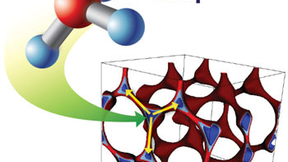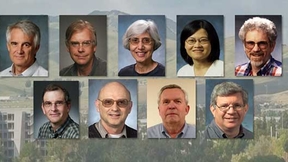Back
Laboratory employees and city officials celebrated the discovery of the two heaviest elements on the periodic table -- 114, Flerovium, and 116, Livermorium -- during a daylong celebration Monday. The day started with a colloquium hosted by the Laboratory, titled "Elemental Science: Livermorium and the Periodic Table," with distinguished lecturers in the Bldg. 123…
Lawrence Livermore researchers for the first time have created movies of irreversible reactions that occur too rapidly to capture with conventional microscopy.The team used multi-frame, nanosecond-scale imaging in the dynamic transmission electron microscope (DTEM) to create movies of the crystallization of phase change materials used for optical and resistive memory. A…
LIVERMORE, Calif.-- Lawrence Livermore National Laboratory researchers have broken the record for tracking the movement and concentration of carbon dioxide in a geologic formation using the world's deepest Electrical Resistance Tomography (ERT) system.The research provides insight into the effects of geological sequestration to mitigate the impact of greenhouse gases.The…
LIVERMORE, Calif. -- Using data derived from nuclear weapons testing of the 1950s and '60s, Lawrence Livermore scientists have found that a small portion of the human brain involved in memory makes new neurons well into adulthood.The research may have profound impacts on human behavior and mental health. The study supports the importance of investigating the therapeutic…
Early Earth was not very hospitable when it came to jump starting life. In fact, new research shows that life on Earth may have come from out of this world.Lawrence Livermore scientist Nir Goldman and University of Ontario Institute of Technology colleague Isaac Tamblyn (a former LLNL postdoc) found that icy comets that crashed into Earth billions of years ago could have…
The Laboratory team behind the discovery of element 116, Livermorium, on the periodic table was honored as one of the Livermore Chamber of Commerce's top Dream-makers and Risk-takers for 2013. Mark and Nancy Stoyer and Jerry Landrum accepted the award on behalf of the 11 researchers who make up the team. Mark Stoyer also provided the keynote address during the chamber…
LIVERMORE, Calif. -- Lawrence Livermore scientists have discovered and demonstrated a new technique to remove and store atmospheric carbon dioxide while generating carbon-negative hydrogen and producing alkalinity, which can be used to offset ocean acidification.The team demonstrated, at a laboratory scale, a system that uses the acidity normally produced in saline water…
Through experiments and simulations, a team of Lawrence Livermore National Laboratory scientists have found that twin boundaries (TBs) with good electrical conductivity and a strengthening mechanism in materials may not be so perfect after all. Coherent twin boundaries (CTBs) have been studied for years and conventional wisdom dictates these interfaces are ideal for…
LLNL has received accolades for its 2012 achievements in waste reduction and green purchasing as part of its participation in the Federal Green Challenge (FGC). The FGC is a voluntary partnership program sponsored by the EPA that challenges federal agencies to reduce their greenhouse gas emissions. FGC participants commit to a minimum 5 percent reduction in two of six…
The distortion of the ancient shoreline and flooding surface of the U.S. Atlantic Coastal Plain are the direct result of fluctuations in topography in the region and could have implications on understanding long-term climate change, according to a new study.Sedimentary rocks from Virginia through Florida show marine flooding during the mid-Pliocene Epoch, which correlates…
The California Energy Commission (CEC) has awarded $1.7 million to a partnership between Lawrence Livermore National Laboratory and Cool Earth Solar Inc. (CES) to conduct a community-scale renewable energy integration demonstration project at the Livermore Valley Open Campus. CES is the prime awardee and is contributing an additional $1 million in matching funds to the CEC…
New evidence from ancient lunar rocks suggests that the moon's long-lived dynamo -- a molten, convecting core of liquid metal that generated a strong magnetic field -- lasted 160 million years longer than originally estimated and was continuously active until well after the final large impacts. Lawrence Livermore scientist William Cassata and a group of international…
Lawrence Fellow Frederico Fiuza is one of three recipients of this year's Ph.D. Research Award from the Plasma Physics Division of the European Physical Society (EPS). Fiuza will receive his award during the 40th EPS plasma physics conference, held in Helsinki, Finland, July 1-5. Fiuza received the award for the work on his doctoral thesis, " Multi-scale PIC Simulations of…
Scientists at Lawrence Livermore National Laboratory (LLNL) and UC Berkeley and have discovered new materials to capture methane, the second highest concentration greenhouse gas emitted into the atmosphere. Methane is a substantial driver of global climate change, contributing 30 percent of current net climate warming. Concern over methane is mounting, due to leaks…
Scientists at Lawrence Livermore National Laboratory (LLNL) and UC Berkeley and have discovered new materials to capture methane, the second highest concentration greenhouse gas emitted into the atmosphere. Methane is a substantial driver of global climate change, contributing 30 percent of current net climate warming. Concern over methane is mounting, due to leaks…
The Environmental Protection Agency (EPA) has formed an independent body to peer-review that agency's research on hydraulic fracturing. The Hydraulic Fracturing Research Advisory Panel, a group of 31 academics and experts, was created by EPA's Science Advisory Board (SAB) to review a congressionally ordered report looking at the potential health impacts of hydraulic…
Nine Laboratory scientists have joined the ranks of 14 other researchers by being named members of the Lab's Distinguished Members of Technical Staff (DMTS) for their extraordinary scientific and technical contributions to the Laboratory and its missions as acknowledged by their professional peers and the larger community. Maya Gokhale of the Computation Directorate, Ernst…
The fellowship named for pioneering Lawrence Livermore computational scientist George Michael is now accepting applications from exceptional PhD students whose research focus is on high-performance computing applications, networking, storage, or large-scale data analysis using the most powerful computers currently available. Recipients of the George Michael Memorial HPC…
Livermore researchers have described in detail the properties of the room temperature form of the element boron.In the periodic table, boron occupies a peculiar, transitional position. It sits on the first row, and has metallic elements to its left, and non-metals to its right. Furthermore, it is the only non-metal in the third column of the periodic table.It is not…
Laboratory scientists played a role in the latest results announced by CERN that provide further evidence that the subatomic particle discovered last year is the elusive Higgs boson, a particle at the heart of the Standard Model of particle physics. The new evidence resulted from the analysis of additional data from the ATLAS and CMS collaborations at the Large Hadron…























